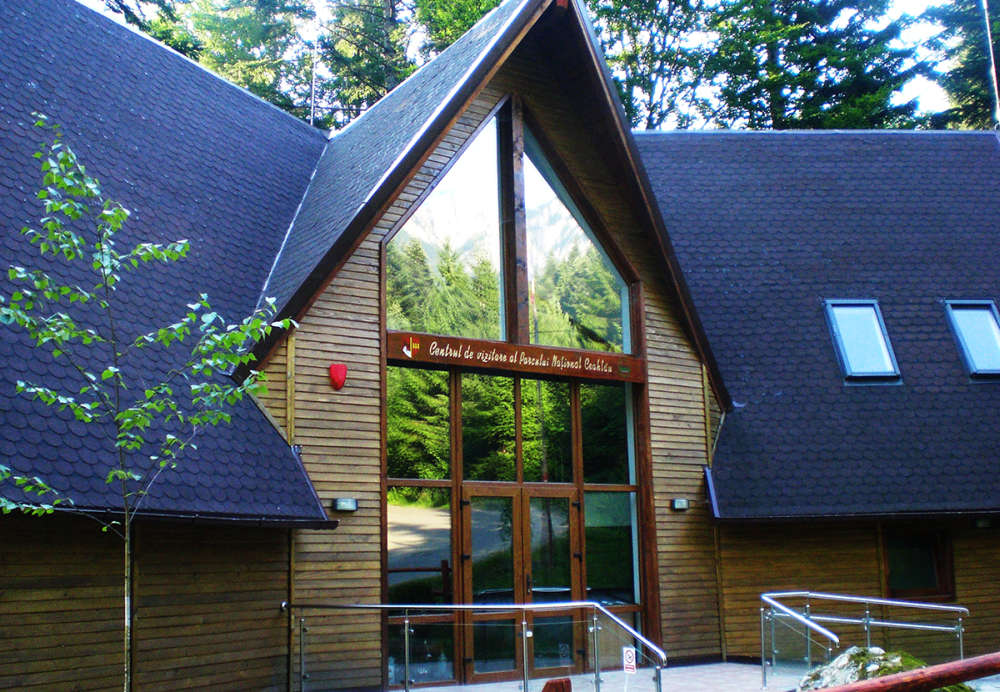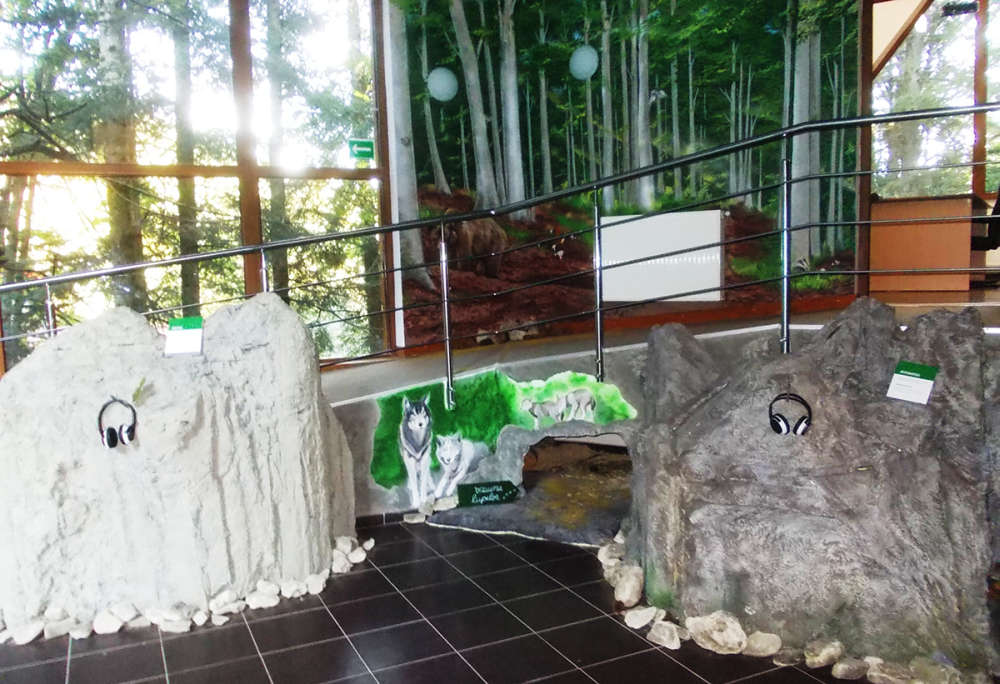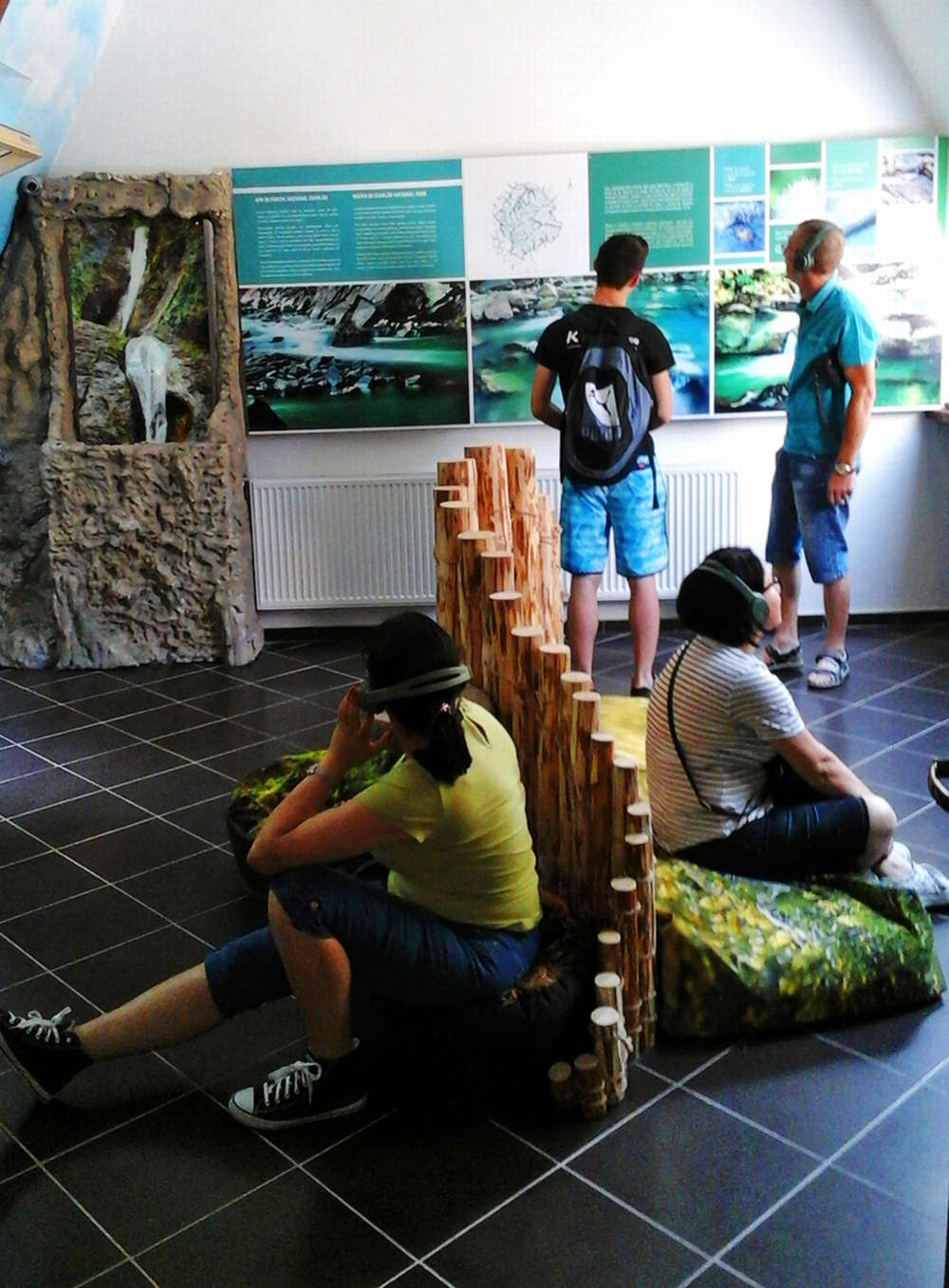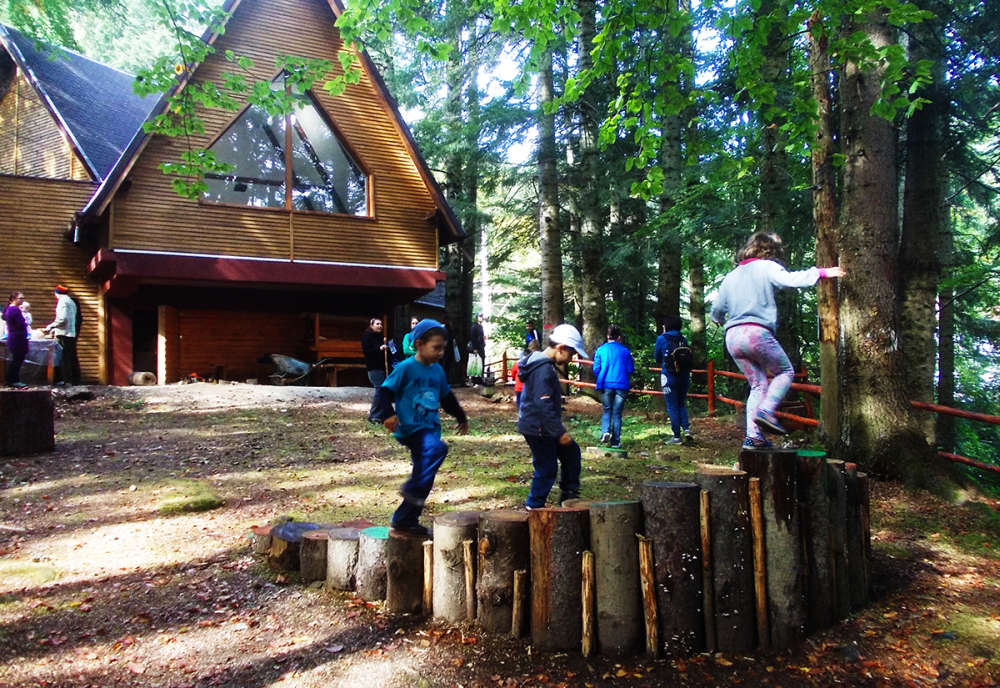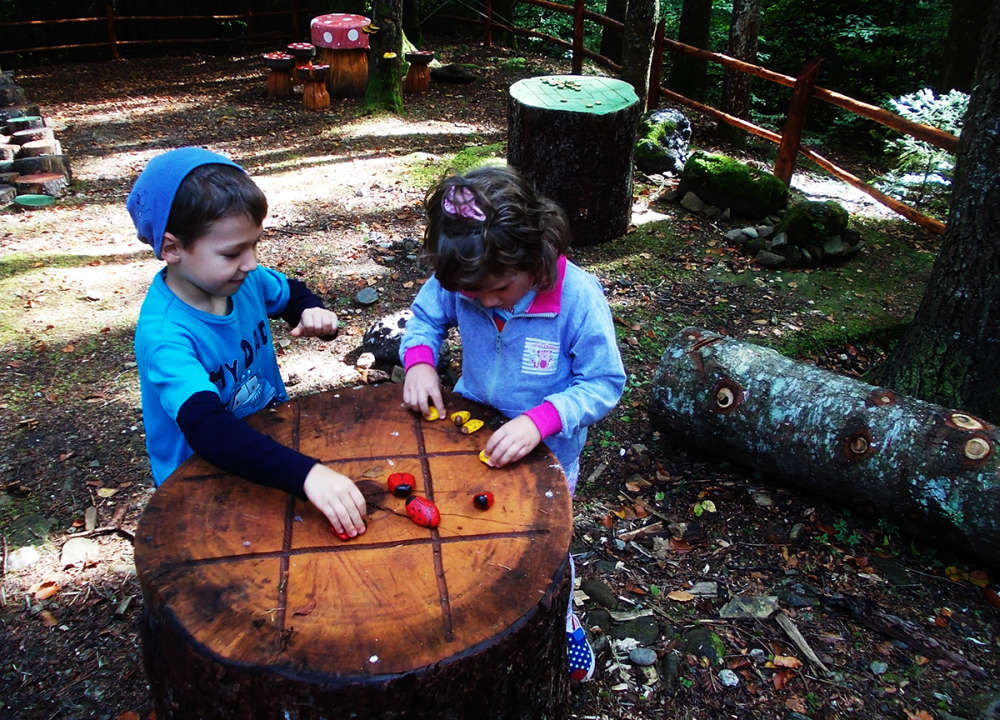Avifauna
Vaduri and Pângărați Lakes are barrier lakes coming into existence in 1966, respectively 1964, being declared areas of special avifaunal protection through Government Ordinance no. 2151 from November 30th, 2004 and Government Ordinance no. 971/2011, ROSPA0125 Vaduri-Pângărați Lakes.
Although Bistrița basin was visited by different aquatic birds before the barrier lakes coming into existence (Munteanu, 2000), their appearance was for a short timeframe, during migration. The development of the lakes offered proper conditions for their longer periods of stay, our literature being notified of frequent nesting, especially with regards to mallards and common sandpipers.
However, due to the abrupt build of the shores of these lakes, the oscillation of the water levels, caused by the practiced consumption of the hydropower plant and due to the immediate vicinity of private properties (households of agricultural crops), the aquatic vegetation is poorly represented, and, as such, nesting havens are few. This aspect leads to a reduction in the number of species and individuals in the nesting period, but the lakes remain an important attraction point during migration for aquatic species. Moreover, the forests and shrubberies in the vicinity hold a specific avifauna, represented by many species.
Species that need protection within the area
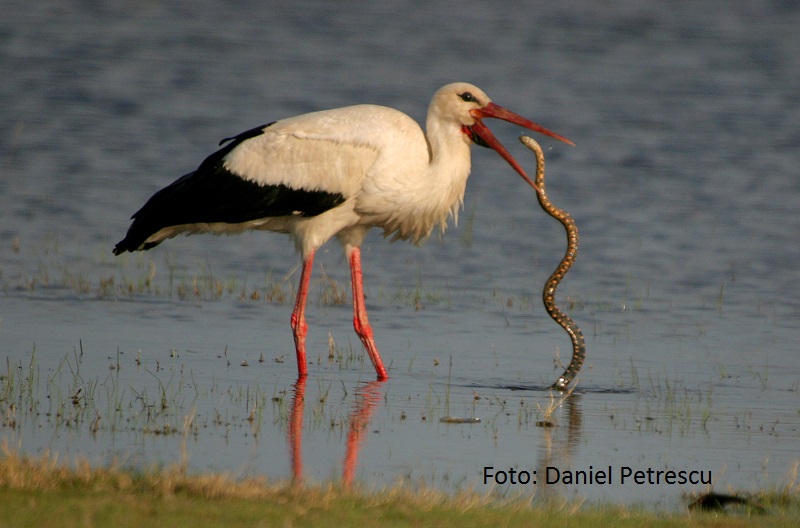 Ciconia ciconia (Linnaeus, 1758) – the White Stork
Ciconia ciconia (Linnaeus, 1758) – the White Stork
The White Stork is a species with an unfavourable conservation status, being included in the SPEC 2 category: numeric reduction. The European population suffered a slow decline in the 19th century and a pronounced one in the 20th century, completely disappearing in some European countries. The European population is estimated at approximately 200,000 pairs, 25% of which being located in Poland. In our country, the stork nests in most parts of the territory, with the exception of mountain areas and almost exclusively in localities. They migrate in great numbers within the country, especially through Transylvania and Moldova-Dobrogea. The annual number of the population is estimated at 4,000-6,000 hatching pairs.
• Habitat: villages and the outskirts of some cities, situated in low lands, rarely in some intra-mountainous depressions, up until an 800 m altitude. The condition for the presence of hatching pairs is the existence of convenient feeding habitats near the nests (wet grasslands, quagmires, marshlands). Presently, the majority of white stork nests are built on electrical network poles, within localities, fewer and fewer nests being situated on buildings (houses, chimneys, stables). Due to the drainage of wet areas and the arid climate of recent years, storks oriented towards the wetter areas of sub-mountainous lands and depressions, alluvial plains and the vicinity of barrier lakes. Presently, storks can be more often found feeding on agricultural crops, stubbles and fallows, as well as grazing lands, far from any water sources.
• Biology: It is a summer guest (March/April – September). It nests during April-July. Spawning consists of 3, sometimes 4 eggs, and exceptionally even 5. Sexual maturity is reached at the age of 3. Storks feed on aquatic animals caught in puddles or swamps, or land animals, such as rodents. Nesting success depends on the level of trophic resources.
• Threats: Dewatering and drainages of extended wetlands, past agricultural collectivization, i.e. the replacement of traditional agricultural practices through methods that determined the homogenisation of the landscape led to a decrease in biodiversity. Moreover, the modernisation of villages, especially by using different roofing materials that do not allow nest building on top of houses, the expansion of high tension electrical networks (collision danger), the use of insecticides and ratsbane in agricultural practices have outstanding repercussions on the hatchlings.
• Protection measures: It is a species protected through Law 13/1993 (Convention of Berne, addendum 2), Law 13/1998 (Convention of Bonn, addendum II), Directive on Birds 2009/147/EC, Laws 407/2006 and 197/2007 (Hunting Law, addendum 2 – forbidden hunting) 89/2000 (AEWA – addendum 2), Government Emergency Ordinance 57/2007 on the regime of natural protected areas, conservation of natural habitats, and of the wild flora and fauna. It is considered to be vulnerable in the national Red List.
• Relationship with the protected area and state of conservation: The species is mentioned in literature (Munteanu, 2000) as being a transit species during spring and accidentally autumn, especially during the first two weeks of April, in groups of 5-30 individuals. 60-120 transit individuals are mentioned in the standard form of the area. The habitat is appropriate for shelter and food over the transit period, both on lake shores and tributary water courses, as well as through the presence of adjacent agricultural crops, with positive perspectives regarding its long term preservation, as a result of the surface being included in the network of areas protected at a European level. As such, the state of conservation of the species within the area is deemed as favourable. Monitoring is necessary over the course of the next years, during the entire transit period, in order to establish whether the visiting population is stable.
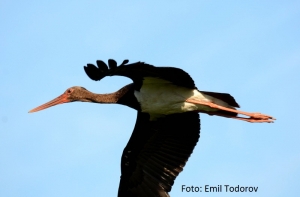 Ciconia nigra (Linnaeus, 1758) – The Black Stork
Ciconia nigra (Linnaeus, 1758) – The Black Stork
It is a species with an unfavourable conservation status (SPEC 2: rare), declining in Europe and especially in Baltic states, completely extinct in Sweden and Spain. Presently a slow increase is noticed, especially in Poland and Belarus. Approximately 7,000-10,000 pairs nest in Europe. In Romania, the prevalence of the species is not sufficiently well known, due to localization difficulties. The population is estimated at 100-150 pairs.
• Habitat: Wide forests with tall trees, unaffected by the presence of humanity, located near flowing or still waters (as trophic habitats). It prefers sub-mountainous areas, on beech and spruce levels.
• Biology: It is a summer guest, from April until October. It can be spotted especially in transit periods, when it rests near lowland waters. It nests during May-July. The nests are located in tall, old trees, with a rich canopy, and they are used for several years in a row. Spawning consists in 3-4 (5) eggs laid at the end of April or during May. Food consists in different aquatic animals, including fish. It is very sensitive near humans.
• Threats: On a European level, the prevalence area of the species acutely narrowed dons, as human activity intensified. The endemic population is affected by the decrease of natural forest areas, by the chopping of old trees, especially oak trees, and by the decrease in aquatic fauna.
• Protection measures: The species is protected through Law 19/1993 (Convention of Berne, addendum 2), Law 13/1998 (Convention of Bonn, addendum II), Directive on Birds 2009/147/EC, Laws 407/2006 and 197/2007 (Hunting Law, addendum 2 – forbidden hunting) 89/2000 (AEWA – addendum 2), Government Emergency Ordinance 57/2007 on the regime of natural protected areas, conservation of natural habitats, and of the wild flora and fauna. It is considered to be vulnerable in the national Red List.
• Relationship with the protected area and state of conservation: The species was spotted during the spring transit, namely three individuals, over Pângărați Lake. 4-8 individuals are mentioned in the standard form of the area, during transit, and literature (Munteanu, 2000) mentions its presence as a summer guest, nesting in areas with wide forests, far away from populated areas, as well as specimen gathered at Pângărați (1963). As such, the state of conservation of the species within the area is deemed favourable, the area offering quality habitats for shelter and feeding over the course of transit, while not registering any direct threats on the species.
• Specific management measurse: protection of specific habitats. Annual monitoring of the population.
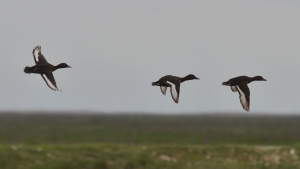 Aythya nyroca (Güldenstädt, 1770) – The Ferruginous duck
Aythya nyroca (Güldenstädt, 1770) – The Ferruginous duck
It is a species undergoing an accentuated decline on the territory of the European Continent, being deemed as part of SPEC 1: vulnerable. Romania is among the countries with a higher number of individuals, estimated at approximately 2,000-6,000 pairs.
• Habitat: It prefers ponds and eutrophic lakes, with abundant aquatic vegetation (rush-beds) and clear water areas. It can be found in natural aquatic basins, but it also nests on ponds, partially cogged up pools or barrage lakes, on which vegetation grows.
• Threats: Limiting factors such as lake draining, habitat degradation through excessive eutrophication, hunting and net fishing in which birds accidentally get trapped and die are factors which determined the decline in the number of ferruginous ducks.
• Protection measures: The species is protected through Law 19/1993 (Convention of Berne, addendum 2), Law 13/1998 (Convention of Bonn, addendum II), Directive on Birds 2009/147/EC, Laws 407/2006 and 197/2007 (Hunting Law, addendum 2 – forbidden hunting) 89/2000 (AEWA – addendum 2), Government Emergency Ordinance 57/2007 on the regime of natural protected areas, conservation of natural habitats, and of the wild flora and fauna. It is considered to be vulnerable in the national Red List.
• Relationship with the protected area and state of conservation: The species was spotted on the area during the course of the study, during the spring transit, over all lakes, with a total of 69 individuals. 36-72 individuals are mentioned in the standard form, while specialty literature mentions it as being an accidental species (Munteanu, 2000). The habitat is fit for shelter and feeding during the transit area and its status is that of area protected on a European level. As such, the state of conservation of the species within the area is deemed as being favourable. Monitoring is required over the course of the following years, during the transit period, in order to establish if the visiting population is stable.
• Specific management measures: Maintaining aquatic vegetation and water quality. Annual monitoring of the population.
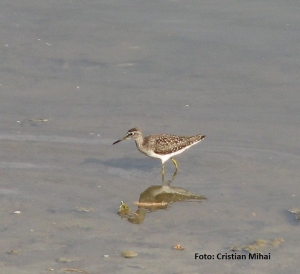 Tringa glareola (Linnaeus, 1758) – The Wood Sandpiper
Tringa glareola (Linnaeus, 1758) – The Wood Sandpiper
It is a wader species characterised by a brownish back with dense light-coloured spots (which are reduced during autumn). The spots present on the dewlap gradually fade away in the white on its chest. Its yellowish-green legs are noticeably longer that the end of its tail during flight.
• Habitat: It can be spotted on the shoreline of waters, in marshlands and in wet areas within birch forests in mountainous areas.
• Biology: It is a migrating bird which transits Romania. It nests in the north of Russia. It lays 3-4 eggs which are hatched for 23 days by both genders. The male is responsible for nurturing the chicks. It feeds on aquatic insects, beetles, worms, spiders, crustaceans, cockles, fish and sometimes vegetation.
• Threats: The main threat is represented by the destruction of shorelines and narrowing of specific habitats.
• Protection measures: It is a species protected through the Directive on Birds 2009/147/EC, Law 13/1993 (Convention of Berne, Addendum II), Law 197/2007 (Law on hunting), Government Emergency Ordinance 57/2007 on the regime of natural protected areas, conservation of natural habitats and of the wild flora and fauna.
• Relationship with the protected area and state of conservation: A number of 50-75 individuals is mentioned in the standard form, while specialty literature deems them an accidental species (Munteanu, 2000). The Habitat is adequate for shelter and feeding over the transit period and has the status of protected area at a European level. As such, the state of conservation of the species within the area is deemed as having insufficient data, it being possible that the observation period does not encompass the maximum period of transit for the species. Monitoring is necessary for the following years, during the entire transit timeframe, in order to establish whether the visiting population is stable or not.
• Specific management measures: the protection of low-water lake shorelines and gravel areas. Annual monitoring of migrating populations.
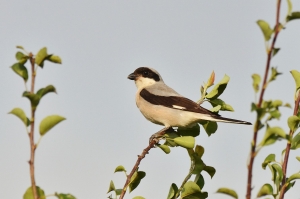 Lanius minor (Gmelin, 1788) – The Lesser Grey Shrike
Lanius minor (Gmelin, 1788) – The Lesser Grey Shrike
A medium sized shrike, grey in colour, with a white abdomen and black wings. What is characteristic for the species is the mask-like black band on its forehead.
• Habitat: It prefers open areas, graze lands bearing shrubs and tree clusters, as well as forest edges.
• Biology: It is a summer guest. It nests during April-July. Spawning consists in 5-6 eggs. Incubation is between 15 and 16 days, and it is the responsibility of the female. Food consists in insects, especially large ones.
• Threats: The main threat is represented by the narrowing of the habitat.
• Protection measures: It is a species protected through the Directive on Birds 2009/147/EC, Law 13/1993 (Convention of Berne, Addendum II), Law 197/2007 (Law on hunting), Government Emergency Ordinance 57/2007 on the regime of natural protected areas, conservation of natural habitats and of the wild flora and fauna.
• Relationship with the protected area and state of conservation: The species is mentioned in the standard form as being a hatching one, with a population estimated at 3-4 pairs. The nesting area of the species could not be determined on land, no individual being observed. In literature (Munteanu, 2000), the species is mentioned as being a rare presence in the region. As such, the conservation status of the species within the area falls under the insufficient data category, with the recommendation of further monitoring of the protected area.
• Specific management measures: Conservation of specific habitats and shrubbery near agricultural crops. Annual monitoring of the species, during its reproduction timeframe (March-April). Avoidance of disturbances caused by human presence.
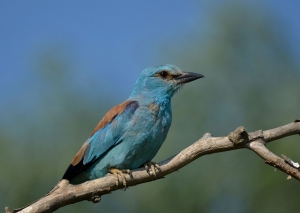 Coracias garrulus (Linnaeus, 1758) – European Roller
Coracias garrulus (Linnaeus, 1758) – European Roller
A medium sized bird, with brightly coloured plumage in tones of blue, reddish brown and black. Its plumage is iridescent, causing the blue feathers to oscillate from ultramarine blue to greenish-blue, depending on the light it is viewed in. It has a solid constitution and a strong beak.
• Habitat: It prefers open areas, with large, hollow trees, orchards, sandy river banks and agricultural areas with clusters of trees.
• Biology: It is a summer guest (March/April – September). It is a monogamous, solitary and territorial bird. It nests in tree hollows and other openings of mountain slopes, river banks, etc. It lays 4-5 eggs which are hatched by the female for 17-19 days. It especially feeds on invertebrates, insects and some small vertebrates. In extraordinary conditions it may also feed on fruit.
• Threats: It is sensitive to the use of pesticides which reduces the quantity of food available, as well as to the modifications brought to exploitation methods and the regime of agricultural crops and forests.
• Protection measures: It is a species protected through the Directive on Birds 2009/147/EC, Law 13/1993 (Convention of Berne, Addendum II), Law 197/2007 (Law on hunting), Government Emergency Ordinance 57/2007 on the regime of natural protected areas, conservation of natural habitats and of the wild flora and fauna.
• Relationship with the protected area and state of conservation: The species is mentioned in the standard form of the area as 1-4 individuals in transit. Specialty literature (Munteanu, 2000) mentions the species as being an accidental presence, very rare in the transit period. As such, data is insufficient in order to characterise the conservation state of the species within the area, falling under the insufficient data category.
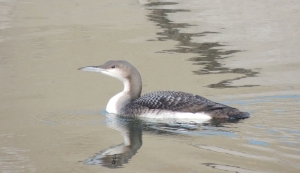 Gavia arctica (Linnaeus, 1758) – The Black-throated Loon
Gavia arctica (Linnaeus, 1758) – The Black-throated Loon
This bird is slightly larger than the common large duck (Anas Platyrhynchos), but more slender in silhouette. Its beak is conical, slim and sharp. Its summer plumage consists in dark colours with white, rectangular spots on the back, as well as alternative white and black vertical lines on its chest and the sides of its neck. Its winter plumage consists in at least half of lateral part of its neck being dark in colour, without white around its eye.
• Habitat: It nests on large and deep freshwater lakes, in the northern part of the globe (Russia, Scandinavia, Alaska and Canada). During wintertime, it can be seen on coasts rich in fish, lakes, estuaries and gulfs.
• Biology: It is a species with an accentuated migrating trait. It nests in isolated pairs, starting with April, depending on local temperature. Its diet consists mainly in fish, but it can also contain cockles, insects and crustaceans, as well as vegetation, from time to time.
• Threats: During the nesting period it is threatened by water pollution and water level variation. During the wintertime it is very vulnerable to pollutant discharge in the waters serving as feeding grounds.
• Protection measures: It is a species protected through the Directive on Birds 2009/147/EC, Law 13/1993 (Convention of Berne, Addendum II), Law 197/2007 (Law on hunting), Government Emergency Ordinance 57/2007 on the regime of natural protected areas, conservation of natural habitats and of the wild flora and fauna.
• Relationship with the protected area and state of conservation: The species is mentioned in the standard form of the area with a population of 7-18 individuals during the winter period.
• Specific management measures: The conservation of aquatic habitats. Maintaining water quality. Monitoring the species during the winter period.
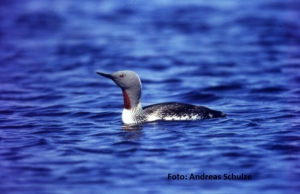 Gavia stellata (Linnaeus, 1758) – The Red-throated Loon
Gavia stellata (Linnaeus, 1758) – The Red-throated Loon
It is the smallest of the loons, but it is not much smaller than the black-throated loon. Its beak is conical, slim, sharp and slightly curved upwards. It is easily recognizable due to the reddish brown neck of its summer plumage. Its winter plumage is lighter than that of the black-throated loon and its eye is surrounded by white.
• Habitat. It nests on small, freshwater lakes, marshlands and wet areas. It prefers areas bare of trees but with shores rich in vegetation. During the winter months, it can be spotted along coasts rich in fish, lakes, estuaries and gulfs.
• Biology. It is a species with an accentuated migrating trait. It nests in isolated pairs or, on large lakes, in clusters, starting with May, and depending on local temperature. It diet is composed mainly of fish, but can also contain cockles, insects and crustaceans, as well as vegetation, from time to time.
• Threats. During the nesting period it is threatened by water pollution and water level variation. During the wintertime it is very vulnerable to pollutant discharge in the waters serving as feeding grounds.
• Protection measures. It is a species protected through the Directive on Birds 2009/147/EC, Law 13/1993 (Convention of Berne, Addendum II), Law 197/2007 (Law on hunting), Government Emergency Ordinance 57/2007 on the regime of natural protected areas, conservation of natural habitats and of the wild flora and fauna.
• Relationship with the protected area and state of conservation. The species is mentioned in the standard form of the area with a population of 4-9 individuals during the winter period. It is necessary for the population to be estimated in the protected area, during the winter season, in order to reach a correct estimation of the state of conservation of the species at the level of the protected area, the species falling under the insufficient data category.
• Specific management measures: The conservation of aquatic habitats. Maintaining water quality. Monitoring the species during the winter period.
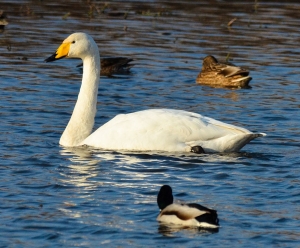 Cygnus cygnus (Linnaeus, 1758) – The Whooper Swan
Cygnus cygnus (Linnaeus, 1758) – The Whooper Swan
It is similar to the common mute swan (Cygnus olor), but it swims with its neck straight and never flaps its wings. The beak sports a different pattern, being made up of yellow and black, as opposed to pink/orange and black.
• Habitat. It nests in the norther extremity of Europe, on islands of wide lake shores and slow flowing rivers, only reaching Romania during the winter period. During winter months, it can be found along the coasts, on large lakes and rivers.
• Biology. It is a migrating species. It nests starting with the middle of May, in solitary pairs and on well-defined territories. Its diet is predominantly herbivorous and consists in leaves, roots and aquatic plants. During winter months it can also consume seeds.
• Threats. It is threatened by the narrowing of its nesting habitat, water pollution and depletion of its food resources.
• Protection measures. It is a species protected through the Directive on Birds 2009/147/EC, Law 13/1993 (Convention of Berne, Addendum II), Law 197/2007 (Law on hunting), Government Emergency Ordinance 57/2007 on the regime of natural protected areas, conservation of natural habitats and of the wild flora and fauna (Addendum 3).
• Relationship with the protected area and state of conservation. The species is mentioned in the standard form of the area with a population of 50-120 individuals which spend the winter here. It was observed in high numbers during the winter months, on all lakes, with a number between 2 and 250 individuals. As such, the species falls under the favourable state of conservation category.
• Specific management measures: Conservation of aquatic habitats. Maintaining water quality. Monitoring the species during the winter period. Maintaining aquatic vegetation. Protection against poaching.
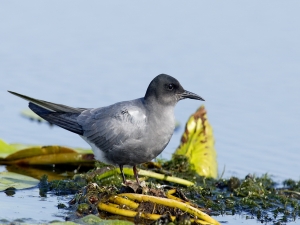 Chlidonias niger (Linnaeus, 1758) – The Black Tern
Chlidonias niger (Linnaeus, 1758) – The Black Tern
It is a small sized tern, with an elegant silhouette and white, grey and black plumage. It has relatively long wings and a short, slightly forked tail. Its reproduction plumage sports a black body and head, its legs also black. Its winter plumage sports a white abdomen and chest, the black on its head fades and its legs become orange.
• Habitat. In order to nest, the black tern requires a habitat rich in vegetation that ensures its shelter, as well as a body of water for feeding. During migration, it uses coasts and large lakes.
• Biology. It nests in colonies, many times in association with other species of tern. Its nest is built on floating vegetation or on the immediate shore. Both parents hatch 2-4 eggs for 21-22 days. Its diet consists in insects, fish and amphibians.
• Threats. The species is sensitive to water modifications in its specific habitats, such as eutrophication of higher levels of acidity in the water. During its nesting period, it is sensitive to water level fluctuations and disturbances caused by the presence of man.
• Protection measures. It is a species protected through the Directive on Birds 2009/147/EC, Law 13/1993 (Convention of Berne, Addendum II), Law 197/2007 (Law on hunting), Government Emergency Ordinance 57/2007 on the regime of natural protected areas, conservation of natural habitats and of the wild flora and fauna.
• Relationship with the protected area and state of conservation. The species is mentioned in the standard form of the area with a population of 300-500 individuals during the transit period. The species has been observed in groups of up to 70 individuals. The state of conservation of the species within the area is favourable. Monitoring is necessary for the following years, during the entire transit period, in order to establish whether the visiting population is stable or not.
• Specific management measures: Conservation of aquatic habitats. Maintaining water quality. Monitoring the species during its transit period.
translated by Andrada-Cristina Dobrea

